2007 CHEVROLET TRAIL BLAZER clock
[x] Cancel search: clockPage 261 of 574

XM™ Satellite Radio Service
XM™ is a satellite radio service that is based in
the 48 contiguous United States and Canada.
XM™ offers a large variety of coast-to-coast
channels including music, news, sports, talk,
traffic/weather (U.S. subscribers), and children’s
programming. XM™ provides digital quality
audio and text information that includes song title
and artist name. A service fee is required in
order to receive the XM™ service. For more
information, contact XM™; In the U.S. at
www.xmradio.com or call 1-800-852-XMXM (9696)
or in Canada at www.xmradio.ca or call
1-877-GET-XMSR (438-9677).
Playing the Radio
PWR (Power):Push this knob to turn the system
on and off.
oVOLUMEp:Turn theoVOLUMEpknob
clockwise or counterclockwise to increase or
to decrease the volume.INFO (Information):When the ignition is off,
press this knob to display the time.
For RDS, press the INFO knob to change what
displays while using RDS. The display options
are station name, RDS station frequency,
PTY, and the name of the program (if available).
For XM™ (if equipped), press the INFO knob
while in XM™ mode to retrieve four different
categories of information related to the current
song or channel: Artist, Song Title, Category
or PTY, Channel Number/Channel Name.
To change the default on the display, press the
INFO knob until you see the desired display, then
hold the knob until a beep sounds. The selected
display becomes the default.
AUTO VOL (Automatic Volume):With automatic
volume, the audio system adjusts automatically
to make up for road and wind noise as you
drive by increasing the volume as vehicle speed
increases.
261
Page 320 of 574
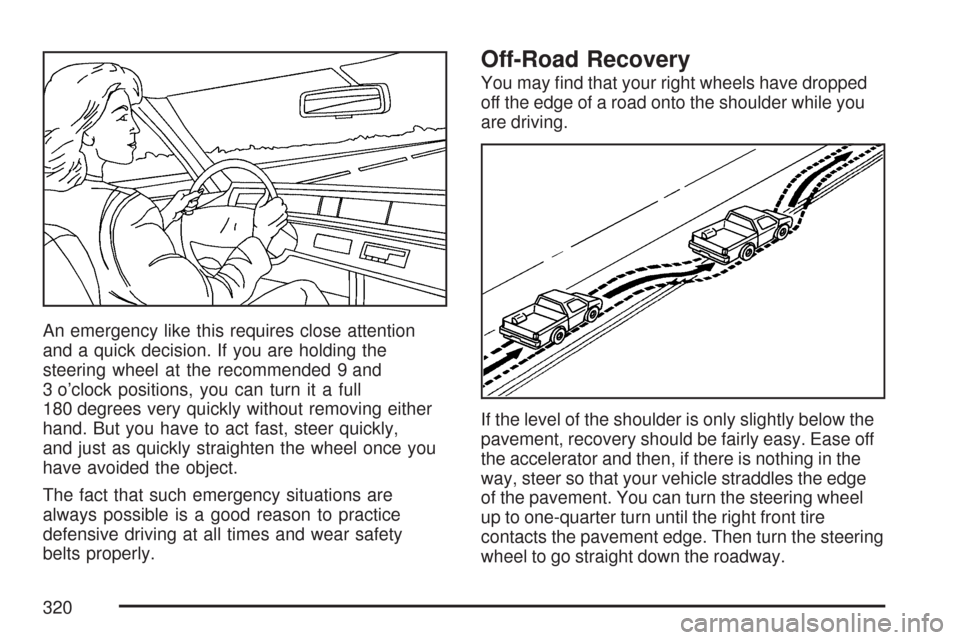
An emergency like this requires close attention
and a quick decision. If you are holding the
steering wheel at the recommended 9 and
3 o’clock positions, you can turn it a full
180 degrees very quickly without removing either
hand. But you have to act fast, steer quickly,
and just as quickly straighten the wheel once you
have avoided the object.
The fact that such emergency situations are
always possible is a good reason to practice
defensive driving at all times and wear safety
belts properly.
Off-Road Recovery
You may �nd that your right wheels have dropped
off the edge of a road onto the shoulder while you
are driving.
If the level of the shoulder is only slightly below the
pavement, recovery should be fairly easy. Ease off
the accelerator and then, if there is nothing in the
way, steer so that your vehicle straddles the edge
of the pavement. You can turn the steering wheel
up to one-quarter turn until the right front tire
contacts the pavement edge. Then turn the steering
wheel to go straight down the roadway.
320
Page 331 of 574

Q:What should I do if my vehicle stalls,
or is about to stall, and I cannot make
it up the hill?
A:If this happens, there are some things you
should do, and there are some things you
must not do. First, here is what youshoulddo:
Push the brake pedal to stop the vehicle
and keep it from rolling backwards. Also,
apply the parking brake.
If the engine is still running, shift the
transmission to REVERSE (R), release
the parking brake, and slowly back down
the hill in REVERSE (R).
If the engine has stopped running, you will need
to restart it. With the brake pedal pressed and
the parking brake still applied, shift the
transmission to PARK (P) and restart the
engine. Then, shift to REVERSE (R), release
the parking brake, and slowly back down the hill
as straight as possible in REVERSE (R).
As you are backing down the hill, put your left
hand on the steering wheel at the 12 o’clock
position. This way, you will be able to tell if the
wheels are straight and maneuver as you back
down. It is best that you back down the hill with
the wheels straight rather than in the left or right
direction. Turning the wheel too far to the left or
right will increase the possibility of a rollover.
Here are some things youmust notdo if you stall,
or are about to stall, when going up a hill.
Never attempt to prevent a stall by shifting
into NEUTRAL (N) to rev-up the engine
and regain forward momentum. This will not
work. Your vehicle will roll backwards
very quickly and you could go out of control.
Instead, apply the regular brake to stop
the vehicle. Then apply the parking brake.
Shift to REVERSE (R), release the parking
brake, and slowly back straight down.
Never attempt to turn around if you are about
to stall when going up a hill. If the hill is steep
enough to stall your vehicle, it is steep
enough to cause you to roll over if you turn
around. If you cannot make it up the hill, you
must back straight down the hill.
331
Page 367 of 574
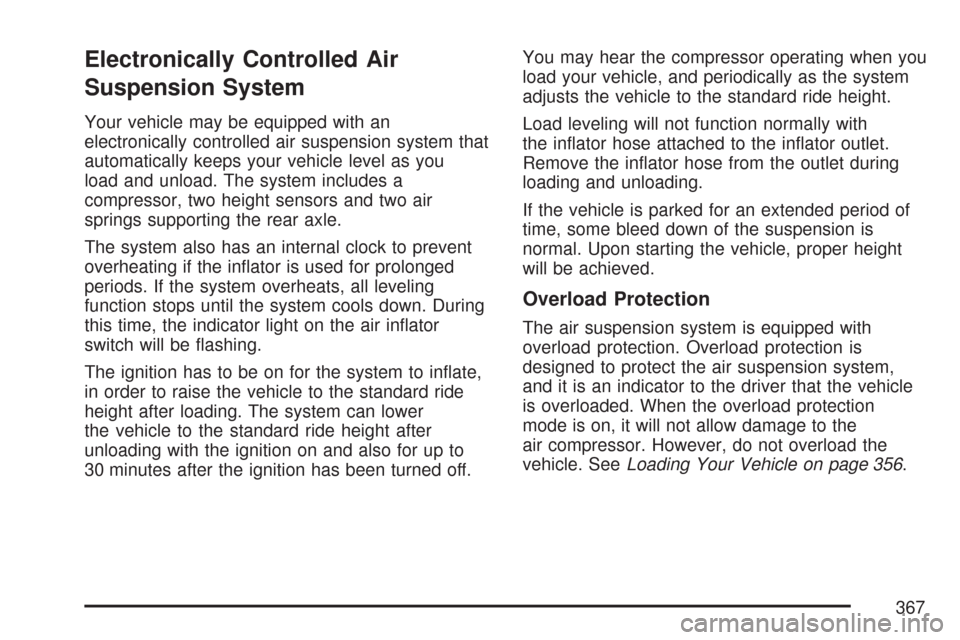
Electronically Controlled Air
Suspension System
Your vehicle may be equipped with an
electronically controlled air suspension system that
automatically keeps your vehicle level as you
load and unload. The system includes a
compressor, two height sensors and two air
springs supporting the rear axle.
The system also has an internal clock to prevent
overheating if the in�ator is used for prolonged
periods. If the system overheats, all leveling
function stops until the system cools down. During
this time, the indicator light on the air in�ator
switch will be �ashing.
The ignition has to be on for the system to in�ate,
in order to raise the vehicle to the standard ride
height after loading. The system can lower
the vehicle to the standard ride height after
unloading with the ignition on and also for up to
30 minutes after the ignition has been turned off.You may hear the compressor operating when you
load your vehicle, and periodically as the system
adjusts the vehicle to the standard ride height.
Load leveling will not function normally with
the in�ator hose attached to the in�ator outlet.
Remove the in�ator hose from the outlet during
loading and unloading.
If the vehicle is parked for an extended period of
time, some bleed down of the suspension is
normal. Upon starting the vehicle, proper height
will be achieved.
Overload Protection
The air suspension system is equipped with
overload protection. Overload protection is
designed to protect the air suspension system,
and it is an indicator to the driver that the vehicle
is overloaded. When the overload protection
mode is on, it will not allow damage to the
air compressor. However, do not overload the
vehicle. SeeLoading Your Vehicle on page 356.
367
Page 391 of 574

Filling the Tank
{CAUTION:
Fuel vapor burns violently and a fuel �re
can cause bad injuries. To help avoid
injuries to you and others, read and follow
all the instructions on the pump island.
Turn off your engine when you are
refueling. Do not smoke if you are near fuel
or refueling your vehicle. Do not use
cellular phones. Keep sparks, �ames, and
smoking materials away from fuel. Do not
leave the fuel pump unattended when
refueling your vehicle. This is against the
law in some places. Do not re-enter the
vehicle while pumping fuel. Keep children
away from the fuel pump; never let children
pump fuel.The tethered fuel cap is located behind a hinged
fuel door on the driver’s side of the vehicle.
To remove the fuel cap, turn it slowly
counterclockwise.
While refueling, hang the tethered fuel cap from
the hook on the fuel door.
391
Page 392 of 574
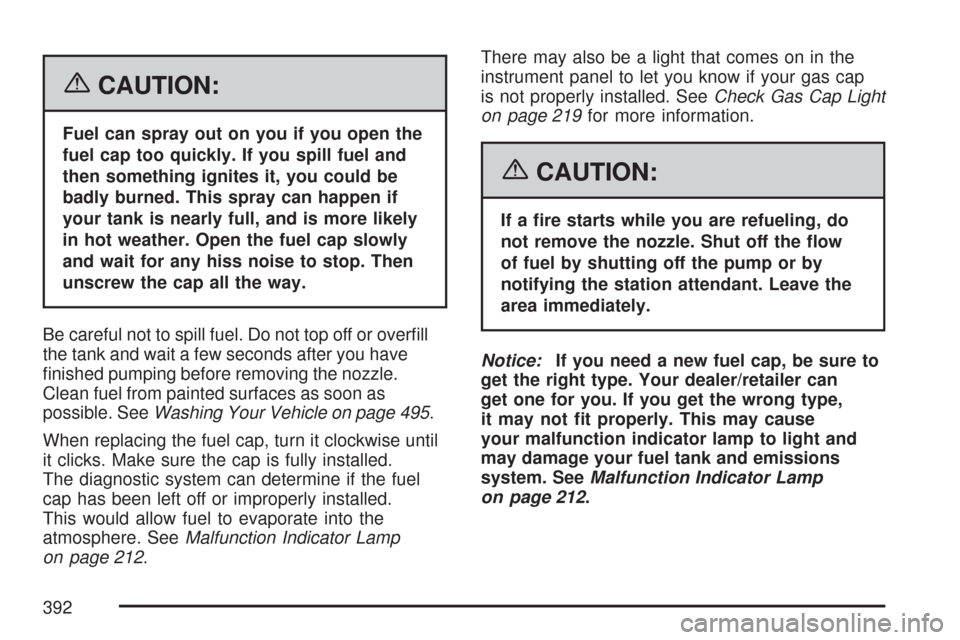
{CAUTION:
Fuel can spray out on you if you open the
fuel cap too quickly. If you spill fuel and
then something ignites it, you could be
badly burned. This spray can happen if
your tank is nearly full, and is more likely
in hot weather. Open the fuel cap slowly
and wait for any hiss noise to stop. Then
unscrew the cap all the way.
Be careful not to spill fuel. Do not top off or over�ll
the tank and wait a few seconds after you have
�nished pumping before removing the nozzle.
Clean fuel from painted surfaces as soon as
possible. SeeWashing Your Vehicle on page 495.
When replacing the fuel cap, turn it clockwise until
it clicks. Make sure the cap is fully installed.
The diagnostic system can determine if the fuel
cap has been left off or improperly installed.
This would allow fuel to evaporate into the
atmosphere. SeeMalfunction Indicator Lamp
on page 212.There may also be a light that comes on in the
instrument panel to let you know if your gas cap
is not properly installed. SeeCheck Gas Cap Light
on page 219for more information.
{CAUTION:
If a �re starts while you are refueling, do
not remove the nozzle. Shut off the �ow
of fuel by shutting off the pump or by
notifying the station attendant. Leave the
area immediately.
Notice:If you need a new fuel cap, be sure to
get the right type. Your dealer/retailer can
get one for you. If you get the wrong type,
it may not �t properly. This may cause
your malfunction indicator lamp to light and
may damage your fuel tank and emissions
system. SeeMalfunction Indicator Lamp
on page 212.
392
Page 423 of 574
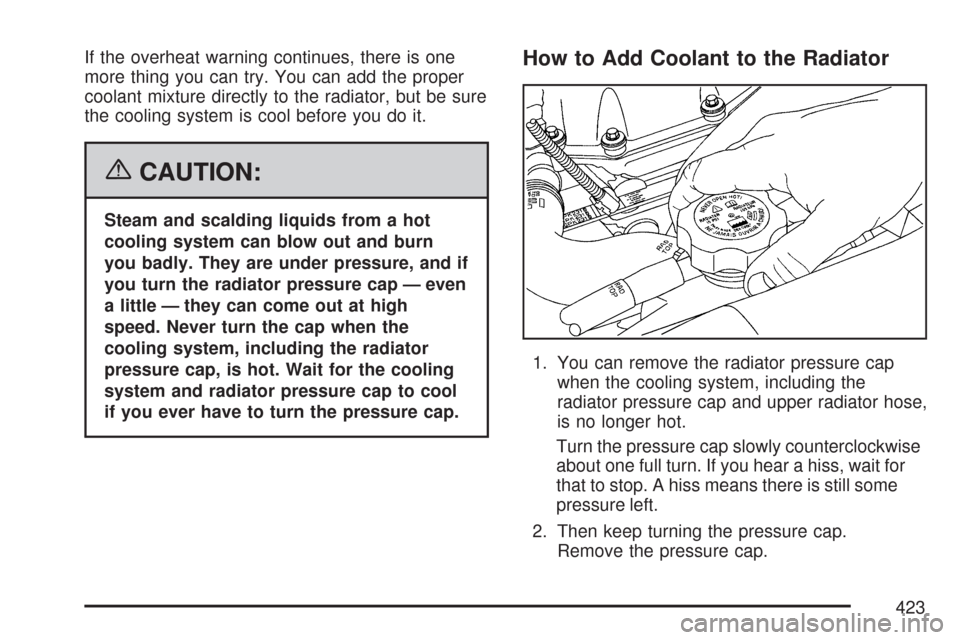
If the overheat warning continues, there is one
more thing you can try. You can add the proper
coolant mixture directly to the radiator, but be sure
the cooling system is cool before you do it.
{CAUTION:
Steam and scalding liquids from a hot
cooling system can blow out and burn
you badly. They are under pressure, and if
you turn the radiator pressure cap — even
a little — they can come out at high
speed. Never turn the cap when the
cooling system, including the radiator
pressure cap, is hot. Wait for the cooling
system and radiator pressure cap to cool
if you ever have to turn the pressure cap.
How to Add Coolant to the Radiator
1. You can remove the radiator pressure cap
when the cooling system, including the
radiator pressure cap and upper radiator hose,
is no longer hot.
Turn the pressure cap slowly counterclockwise
about one full turn. If you hear a hiss, wait for
that to stop. A hiss means there is still some
pressure left.
2. Then keep turning the pressure cap.
Remove the pressure cap.
423
Page 473 of 574
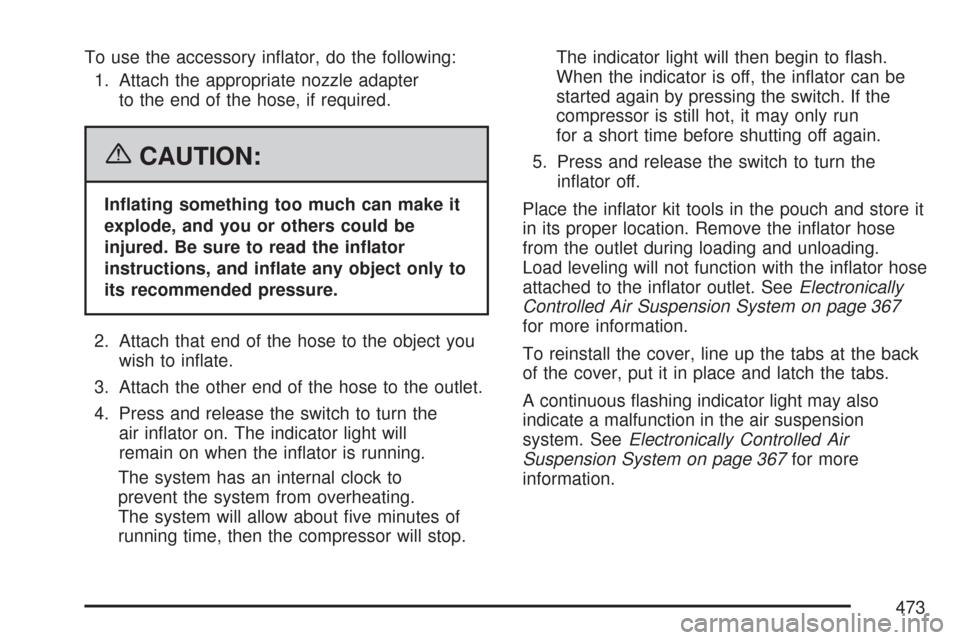
To use the accessory in�ator, do the following:
1. Attach the appropriate nozzle adapter
to the end of the hose, if required.
{CAUTION:
In�ating something too much can make it
explode, and you or others could be
injured. Be sure to read the in�ator
instructions, and in�ate any object only to
its recommended pressure.
2. Attach that end of the hose to the object you
wish to in�ate.
3. Attach the other end of the hose to the outlet.
4. Press and release the switch to turn the
air in�ator on. The indicator light will
remain on when the in�ator is running.
The system has an internal clock to
prevent the system from overheating.
The system will allow about �ve minutes of
running time, then the compressor will stop.The indicator light will then begin to �ash.
When the indicator is off, the in�ator can be
started again by pressing the switch. If the
compressor is still hot, it may only run
for a short time before shutting off again.
5. Press and release the switch to turn the
in�ator off.
Place the in�ator kit tools in the pouch and store it
in its proper location. Remove the in�ator hose
from the outlet during loading and unloading.
Load leveling will not function with the in�ator hose
attached to the in�ator outlet. SeeElectronically
Controlled Air Suspension System on page 367
for more information.
To reinstall the cover, line up the tabs at the back
of the cover, put it in place and latch the tabs.
A continuous �ashing indicator light may also
indicate a malfunction in the air suspension
system. SeeElectronically Controlled Air
Suspension System on page 367for more
information.
473